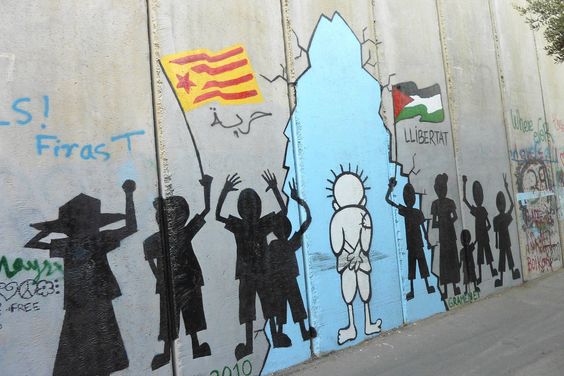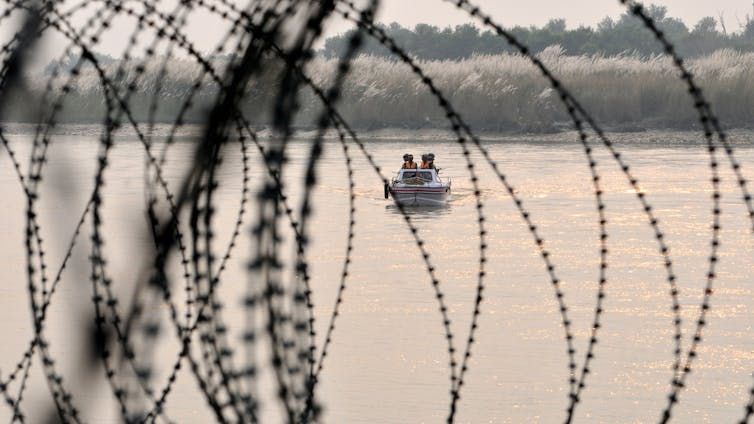The State of Palestine has been recognized by 139 of the 193 UN members and has had the status of a non-member observer state in the United Nations since 2012.
USA, Canada, UK, the EU, Norway and Australia or the socalled “Free World” with its high standard western values of lieberty and freedom supports the genozidal apartheid state of Israel while the east and the former colonies in the south stands with Palestine and their struggle for freedom. By Night w, CC BY-SA 3.0, Link
On 29 November 2012, in a 138–9 vote (with 41 abstentions and 5 absences), the United Nations General Assembly passed resolution 67/19, upgrading Palestine from an “observer entity” to a “non-member observer state” within the United Nations System, which was described as recognition of the PLO’s sovereignty.
Palestine (Arabic: فلسطين, romanized: Filasṭīn), officially the State of Palestine (دولة فلسطين, Dawlat Filasṭīn), is a state in the Southern Levant region of West Asia. Founded on 15 November 1988 and officially governed by the Palestine Liberation Organization (PLO), it claims the West Bank (including East Jerusalem) and the Gaza Strip as its territory, all of which have been Israeli-occupied territories since the 1967 Six-Day War. The West Bank contains 165 Palestinian enclaves that are under partial Palestinian rule, but the remainder, including 200 Israeli settlements, is under full Israeli control. The Gaza Strip was governed by Egypt but conquered by Israel in 1967. Israel governed the region until it withdrew in 2005, although it is still considered to occupy Gaza. Hamas seized power after winning the 2006 Palestinian legislative election. The Gaza Strip has since been blockaded by Israel and Egypt.
After World War II, in 1947, the United Nations (UN) adopted a Partition Plan for Mandatory Palestine, which recommended the creation of independent Arab and Jewish states and an internationalized Jerusalem. Immediately after the United Nations General Assembly adopted the plan as Resolution 181, a civil war broke out in Palestine, and the plan was not implemented. The day after the establishment of the State of Israel on 14 May 1948, neighboring Arab countries invaded the former British Mandate and engaged Israeli forces in the 1948 Arab–Israeli War. Later, the All-Palestine Government was established by the Arab League on 22 September 1948 to govern the All-Palestine Protectorate in the Egyptian-occupied Gaza Strip. It was soon recognized by all Arab League members except Transjordan, which had occupied and later annexed the West Bank, including East Jerusalem. The jurisdiction of the All-Palestine Government was declared to cover the whole of the former Mandatory Palestine; its effective jurisdiction was limited to the Gaza Strip. During the Six-Day War in June 1967, Israel captured the Gaza Strip and the Sinai Peninsula from Egypt, the West Bank and East Jerusalem from Jordan, and the Golan Heights from Syria.
On 15 November 1988 in Algiers, Yasser Arafat, as Chairman of the PLO, issued the Palestinian Declaration of Independence, which established the State of Palestine. A year after the signing of the Oslo Accords in 1993, the Palestinian National Authority (PNA) was formed to govern (in varying degrees) areas A and B in the West Bank, comprising 165 enclaves and the Gaza Strip. After Hamas became the PNA parliament‘s leading party in the most recent elections (2006), a conflict broke out between it and the Fatah party, leading to the Gaza Strip being taken over by Hamas in 2007 (two years after the Israeli disengagement).
The State of Palestine’s mid-year population in 2021 was 5,227,193. Although Palestine claims Jerusalem as its capital, the city is under the control of Israel; both Palestinian and Israeli claims to the city are mostly unrecognized by the international community. Palestine is a member of the Arab League, the Organisation of Islamic Cooperation, the G77, the International Olympic Committee, as well as UNESCO, UNCTAD and the International Criminal Court. Following a failed attempt in 2011 to secure full United Nations member-state status, the United Nations General Assembly voted in 2012 to recognize Palestine as a non-member observer state.
The Nakba
The Nakba (Arabic: النكبة an-Nakbah, lit. ’The Catastrophe’) is the violent displacement and dispossession of the Palestinian people, along with the destruction of their society, culture, identity, political rights, and national aspirations.[1] The term is used to describe the events that took place during the 1948 Palestine war, as well as the ongoing persecution and displacement of Palestinians by Israel throughout the Palestinian territories (the West Bank and the Gaza Strip).
During the foundational events of the Nakba in 1948, dozens of massacres targeting Arabs were conducted, and about 400 Arab-majority towns and villages were depopulated, with many of these being either completely destroyed or repopulated by Jewish residents and given new Hebrew names. Approximately 750,000 Palestinian Arabs (about half of Palestine’s Arab population) fled from their homes or were expelled by Zionist militias and later the Israeli army in what is now Israel proper, which covers 78% of the total land area of the former Mandatory Palestine.
As a whole, the Nakba covers the long-running rejection of the Palestinian right of return, the creation of permanent Palestinian refugees, and the “shattering of Palestinian society” for the establishment of a Jewish state.
Many scholars, including Israeli historian Ilan Pappé, describe the events of the Nakba (especially the expulsions of 1948) as ethnic cleansing, but this categorization has been disputed by other scholars, such as Israeli historian Benny Morris. The Palestinian national narrative views the Nakba as a collective trauma that defines their national identity and political aspirations, whereas the Israeli national narrative views the same events in terms of the war of independence that established Jewish aspirations for statehood and sovereignty. To this end, the Palestinians observe 15 May as Nakba Day, commemorating the war’s events one day after Israel’s Independence Day.
The Nakba has greatly influenced Palestinian culture and is a foundational symbol of the current Palestinian national identity, together with the political cartoon character Handala, the Palestinian keffiyeh, and the Palestinian 1948 keys. Countless books, songs, and poems have been written about the Nakba. Palestinian poet Mahmoud Darwish described the Nakba as “an extended present that promises to continue in the future” as the Israeli–Palestinian peace process falters.

Entrance to the Aida refugee camp, near Bethlehem, CC0, Link
Ottoman and British Mandate periods (prior to 1948)
The roots of the Nakba are traced to the arrival of Zionists and their purchase of land in Ottoman Palestine in the late 19th century. Zionists wanted to create a Jewish state in Palestine with as much land, as many Jews, and as few Palestinian Arabs as possible. By the time the British announced their official support for Zionism in the 1917 Balfour Declaration during World War I, the population of Palestine was about 750,000, approximately 94% Arab and 6% Jewish.
After the partition of the Ottoman Empire, British-ruled Mandatory Palestine began in 1922. By then, the Jewish population had grown to around 10%; both the Balfour Declaration and the Mandate for Palestine referred to the 90% Arab population as “existing non-Jewish communities.”
Following World War II and the Holocaust, in February 1947, the British declared they would end the Mandate and submit the future of Palestine to the newly-created United Nations for resolution. The United Nations Special Committee on Palestine (UNSCOP) was created, and in September, submitted a report to the UN General Assembly recommending partition. Palestinians were opposed to the partition. Zionists accepted the partition but planned to expand Israel’s borders beyond what was allocated to it by the UN.
On 29 November 1947, the General Assembly passed Resolution 181 (II), the “United Nations Partition Plan for Palestine.” At the time, Arabs made up about two-thirds of the population and owned about 90% of the land, while Jews made up between a quarter and a third of the population and owned about 7% of the land. The UN partition plan allocated to Israel about 55% of the land, where the population was about 500,000 Jews and 407,000-438,000 Arabs. Palestine was allocated the remaining 45% of the land, where the population was about 725,000-818,000 Arabs and 10,000 Jews. Jerusalem and Bethlehem were to be internationally-governed corpus separatum with a population of about 100,000 Arabs and 100,000 Jews.
The 1948 Nakba
The central facts of the Nakba during the 1948 Palestine war are not disputed. Approximately 750,000 Palestinians–over 80% of the population in what would become Israel–were expelled or fled from their homes and became refugees in neighboring states. Cities and hundreds of towns and villages were destroyed or depopulated. Thousands of Palestinians were killed in dozens of massacres. About a dozen rapes of Palestinians by regular and irregular Israeli military forces have been documented, and more are suspected. Looting by Israeli soldiers and civilians of Palestinian homes, business, farms, artwork, books, and archives was widespread.
Small-scale local skirmishes began on 30 November and gradually escalated until March 1948. Most of the violence during the first half of the conflict occurred in and around urban centers, in the Israeli portion of the partitioned land, while British troops were still present. When the violence started, Palestinians had already begun fleeing, expecting to return after the war.
The massacre and expulsion of Palestinian Arabs and destruction of villages began in December, including massacres at Al-Khisas (18 December 1947), and Balad al-Shaykh (31 December). By March, between 70,000 and 100,000 Palestinians, mostly middle- and upper-class urban elites, were expelled or fled.
In early April 1948, the Israelis launched Plan Dalet, a large-scale offensive. Over 200 villages were destroyed during this period. Massacres and expulsions continued, including at Deir Yassin (9 April 1948). Arab urban centers in Tiberias (18 April), Haifa (23 April), West Jerusalem (24 April), Acre (6-18 May), Safed (10 May), and Jaffa (13 May) were depopulated.
On 14 May, the Mandate formally ended, the last British troops left, and Israel declared independence. By that time, Palestinian society was destroyed and over 300,000 Palestinians had been expelled or fled. On 15 May, Jordan, Egypt, Syria, Lebanon, and Iraq entered the war, beginning its second phase. Two truces were signed in early June and mid-July, the second lasting until October.

Israel seized land allocated to the Palestinians by the UN partition plan during this period, and expulsions, massacres, and the destruction of villages in rural areas increased, including the Tantura massacre (22-23 May) and the expulsion of tens of thousands from Lydda and Ramle (9-13 July).
In October, the ceasefire was broken, and Israeli expansion continued, including the depopulation of Beersheba (21 October), the al-Dawayima massacre (29 October), and the Safsaf massacre (also 29 October).
Most of the fighting ended by the winter of 1948. By then, Israel held about 78% of Palestine, including about half of the Arab state proposed by the UN partition plan. About 156,000 Palestinians remained within the borders of Israel, many becoming internally displaced persons. The Gaza Strip came under Egyptian control, and the West Bank was annexed by Jordan. Armistices were signed between February and July 1949, formally ending the war.
Military governance period (1949–1966)
The Nakba continued after the end of the war in 1949. From 1948 to 1966, Palestinians in Israel lived under martial law, subject to strict curfews, travel restrictions, and other restrictions. Israel prevented Palestinian refugees outside of Israel from returning. Palestinians continued to be expelled, and more Palestinian towns and villages were destroyed, with new Israeli settlements established in their place.
Palestinian place names and the name “Palestine” itself were removed from maps and books.
Sixty-nine Palestinians were killed in the 1953 Qibya massacre; a few years later, 49 Palestinians were killed in the Kafr Qasim massacre, on the first day of the 1956 Suez Crisis.
Naksa period (1967–1986)
During the 1967 Six-Day War, hundreds of thousands of Palestinian refugees were driven from the West Bank, Gaza, and East Jerusalem. Most were driven into Jordan. This has become known as al-Naksa (the “setback”). After the war, Israel occupied the West Bank and Gaza Strip.
Some two thousand Palestinians were killed in a massacre led by the Lebanese Front at the Siege of Tel al-Zaatar in 1976, during the Lebanese Civil War.
Palestinian refugees in Lebanon were killed or displaced during the 1982 Lebanon War, including between 800 and 3,500 killed in the Sabra and Shatila massacre.
Since the First Intifada (1987-present)
The First Intifada began in 1987 and lasted until the 1993 Oslo Accords. The Second Intifada began in 2000. In 2005, Israel withdrew from Gaza and blockaded it. In the West Bank and East Jerusalem, Israel has built the Israeli West Bank barrier and created Palestinian enclaves.
In 2011, Israel passed the Nakba Law, which denies government funding to institutions that commemorate the Nakba.
The 2023 Israel-Hamas War has caused the highest Palestinian casualties since the 1948 war, and has raised fears among Palestinians that history will repeat itself. These fears were exacerbated when Israeli Agricultural Minister Avi Dichter said that the war would end with “Gaza Nakba 2023.”

Handala (Arabic: حنظلة, romanized: Ḥanẓala), also Handhala, Hanzala or Hanthala, is a prominent national symbol and personification of the Palestinian people. Handala’s age – ten years old – represents Naji al-Ali‘s age in 1948 when he was forced to leave Palestine and would not grow up until he could return to his homeland: Al-Ali wrote that: Handala was born 10 years old and he will always be 10 years old. It was at that age that I left my homeland. When Handala returns, he will still be 10 years old, and then he will start growing up. His posture, with his turned back and clasped hands symbolise the character’s “rejection at a time when solutions are presented to us the American way” and as “a symbol of rejection of all the present negative tides in our region.” Handala’s ragged clothes and standing barefoot symbolise his allegiance to the poor. Al-Ali described Handala as “the symbol of a just cause”.
Al-Ali stated in an interview prior to his assassination: “Handala, whom I created, will not end after I die. I hope that this is not an exaggeration when I say that I will continue to live in Handala, even after I die”.




Comments are closed.